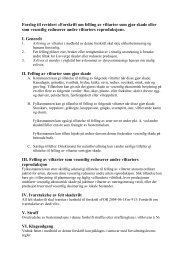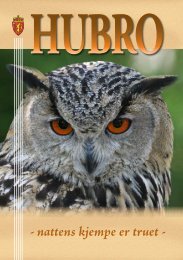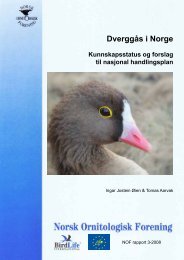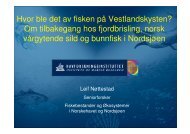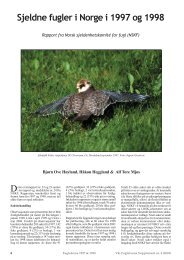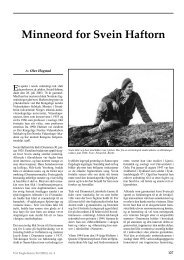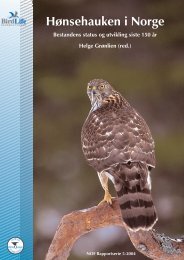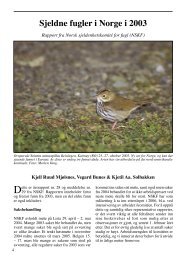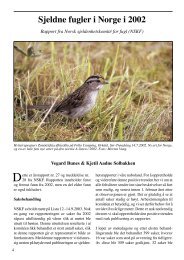Fennoscandian Lesser White-fronted Goose conservation project ...
Fennoscandian Lesser White-fronted Goose conservation project ...
Fennoscandian Lesser White-fronted Goose conservation project ...
You also want an ePaper? Increase the reach of your titles
YUMPU automatically turns print PDFs into web optimized ePapers that Google loves.
<strong>Lesser</strong> <strong>White</strong>-<strong>fronted</strong><br />
<strong>Goose</strong> protected in<br />
Turkmenia<br />
The State Committee for Environmental<br />
Protection of Russia organised a<br />
conference concerning the strategy of use<br />
and <strong>conservation</strong> of Russian wetlands in<br />
the period 24-26 February, 1999 in<br />
Moscow. During the conference, the<br />
protection of the <strong>Lesser</strong> <strong>White</strong>-<strong>fronted</strong><br />
<strong>Goose</strong> (Anser erythropus, later LWfG)<br />
within the Russian Federation and also in<br />
other neighbouring countries was<br />
discussed between the nature <strong>conservation</strong><br />
authorities and scientists. A Turkmenian<br />
scientist asked for contribution to compile<br />
an appeal to Turkmenian authorities<br />
concerning the protection of the LWfG in<br />
Turkmenia. According to him, LWfG was<br />
added to the Red Data Book of Turkmenia<br />
on 21 June, 1999. This is the first step in<br />
protection of the LWfG in Turkmenia.<br />
Turkmenia has formerly been, and<br />
could possibly still be an important<br />
wintering ground for the LWfG. This was<br />
also indicated by the International<br />
Waterbird Census (IWC) last spring, when<br />
Eldar A. Rustamov observed 43 LWfG at<br />
Krasnovodsk Gulf (39º42'–40º02’N,<br />
52º53'–53º32’E) in the period 15-18<br />
March, 1999, and further395 LWfG<br />
somewhat more east at Balkhan Gulf<br />
(39º49'–40º02’N, 53º32'–53º50’E) in the<br />
period 19–20 March, 1999.<br />
Juha Markkola<br />
New information about<br />
wintering <strong>Lesser</strong> <strong>White</strong><strong>fronted</strong><br />
Geese in<br />
Uzbekistan<br />
In spring 1999, a study titled ”Review on<br />
Anatidae species and their key sites in<br />
Uzbekistan” was published in Uzbekistan by<br />
Kreuzberg-Mukhina et al. In this review,<br />
lesser <strong>White</strong>-<strong>fronted</strong> <strong>Goose</strong> (Anser<br />
erythropus, later LWfG) is said to be<br />
wintering and also regularly hunted in the<br />
Surkhandarya region, along the upper<br />
stretches of River Amudarya (37º14’N,<br />
67º47’ E), in the bordering areas between<br />
Uzbekistan and Afghanistan and close to the<br />
border of Tadjikistan. LWfG is proposed to<br />
be included in the Appendix of the Red Data<br />
Book of Threatened Animals of Uzbekistan<br />
(Asimov 1996) as a rare migrant for which<br />
hunting and trapping should be forbidden.<br />
According to the review, the proportion<br />
of LWfG in hunting bags of geese during<br />
winter in the area indicate a rough estimate<br />
of 2000–4000 wintering LWfG. This incur<br />
that Uzbekistan could be one of the most<br />
<strong>Fennoscandian</strong> <strong>Lesser</strong> <strong>White</strong>-<strong>fronted</strong> <strong>Goose</strong> <strong>conservation</strong> <strong>project</strong> – Annual report 1999<br />
SHORT NEWS<br />
important wintering places for LWfG along<br />
the European-Siberian-Caspian flyway by<br />
now. However, one needs to keep in mind<br />
(as shown e.g. in Kazakstan; see Tolvanen et<br />
al. 2000, pp. 43–50 in this report) that the<br />
statistics of the hunting bags can be<br />
unreliable, as <strong>White</strong>-<strong>fronted</strong> Geese (A.<br />
albifrons) are commonly erroneously<br />
identified as LWfG.<br />
Original text of the review (English<br />
slightly revised) is as follows:<br />
"<strong>Lesser</strong> <strong>White</strong>-<strong>fronted</strong> <strong>Goose</strong> - Anser<br />
erythropus. Status: For this species there is<br />
only one reliable old finding known (April,<br />
1944) in the lower parts of the Amudarya<br />
river. Data on migration and wintering is<br />
practically missing (Kashkarov 1987), but in<br />
Surkhandarya region (high parts of<br />
Amudarya, near Termez), flocks of LWfG are<br />
wintering regularly. In 1990, the proportion<br />
of LWfG in the hunting bag was evaluated to<br />
be c. 20-30%. The <strong>Lesser</strong> <strong>White</strong>-<strong>fronted</strong><br />
<strong>Goose</strong> is present in c.20 % of goose flocks,<br />
mainly consisting of Greylag Geese (Anser<br />
anser). In Chardara water reservoir LWfG<br />
has been hunted occasionally during the last<br />
years. LWfG commonly occur in flocks of 8-<br />
10 birds (Nazarov unpubl.).<br />
Conservation status: This species is<br />
suggested to be included in the Appendix of<br />
the Red Data Book of Threatened Animals of<br />
Uzbekistan (Asimov 1996) as rare migrant.<br />
Hunting and trapping should be forbidden".<br />
References<br />
Asimov, D.A., Abdunazarov, B.B.,<br />
Vashetko, E.V., Lanovenko, Ye.N.,<br />
Zinoviev, S.A., Mukhina, E.A.,<br />
Mirzaev, U.T., Khodjaev, A.F.,<br />
Shernazarov, E.Sh. 1996: Rare and<br />
vanishing animal species of Uzbekistan .<br />
Informative bull. 27 pg. Tashkent,<br />
"FAN". (In Russian)<br />
Kashkarov, D. Yu. 1987: Order<br />
Anseriformes. In: Birds of Uzbekistan,<br />
V.1:57–123. Tashkent, ”FAN”. (In<br />
Russian)<br />
Kreuzberg-Mukhina E.A., Kashkarov, D.<br />
Yu., Lanovanko Ye., N., Nazarov, O.P.,<br />
Elmurod, Sh. & Shernazarov, E.Sh.<br />
1999: Review on Anatidae species and<br />
their key sites in Uzbekistan.<br />
Tolvanen, P., Eskelin, T., Aarvak, T.,<br />
Eichhorn, G., Øien, I.J. & Gurtovaya,<br />
E. 2000: Monitoring the autumn staging<br />
of <strong>Lesser</strong> <strong>White</strong>-<strong>fronted</strong> Geese in<br />
Kazakstan, October 1999. In: Tolvanen,<br />
P., Øien, I.J. & Ruokolainen, K. (eds.):<br />
<strong>Fennoscandian</strong> <strong>Lesser</strong> <strong>White</strong>-<strong>fronted</strong><br />
<strong>Goose</strong> Conservation Project. Annual<br />
report 1999. – WWF Finland Report 12<br />
& Norwegian Ornithological Society,<br />
NOF Rapportserie report no. 1-2000:43–<br />
50.<br />
Elena Kreuzberg-Mukhina & Juha Markkola<br />
Status of the<br />
awareness campaign<br />
for the <strong>Lesser</strong> <strong>White</strong><strong>fronted</strong><br />
<strong>Goose</strong><br />
Introduction<br />
The awareness campaign for the <strong>Lesser</strong><br />
<strong>White</strong>-<strong>fronted</strong> <strong>Goose</strong> (Anser erythropus,<br />
later LWfG) was implemented in the<br />
autumn 1998. The basic need is to increase<br />
the knowledge and raise awareness on the<br />
species' situation among management<br />
authorities, and especially, hunters in the<br />
countries hosting staging or wintering<br />
populations of the species (Kostadinova et<br />
al. 1999). The campaign was initiated by<br />
the Norwegian Ornithological Society<br />
(NOF) and the Bulgarian Society for the<br />
Protection of Birds (BSPB) has been<br />
responsible for the production of the<br />
information material on the ecology,<br />
occurrence and identification of LWfG<br />
(posters and stickers). This material was<br />
produced during 1998 and 1999 in order to<br />
be distributed in villages, among groups of<br />
hunters and in local/regional<br />
administration offices.<br />
The aims of the campaign have been<br />
to: Raise awareness among hunters, and<br />
try to move the hunting pressure away<br />
from the LWfG to a sustainable hunting on<br />
the more numerous goose species, e.g.<br />
Greylag <strong>Goose</strong> (A. anser) and <strong>White</strong><strong>fronted</strong><br />
<strong>Goose</strong> (A. albifrons).<br />
Status of the Awareness campaign<br />
The preparation work on the production of<br />
information material (poster/sticker) was<br />
carried out in 1998 and 1999. During<br />
1999 altogether 11,740 posters and 23,800<br />
stickers are produced in eight different<br />
languages/versions. The printed material<br />
describes the ecology, occurrence and<br />
identification of LWfG in the languages of<br />
seven key countries where the LWfG is<br />
threatened by hunting - Kazakstan,<br />
Azerbaijan, Ukraine, Bulgaria, Hungary,<br />
Romania and Russia. For Kazakstan,<br />
which possess spring and autumn<br />
gathering sites of major importance for<br />
both the <strong>Fennoscandian</strong> and the western<br />
Siberian populations of LWfG, both a<br />
Russian and a Kazak language version is<br />
produced. In addition, we made an English<br />
version of the information material for<br />
general information and international<br />
promotion of the LWfG <strong>conservation</strong><br />
work.<br />
The printed material is now distributed<br />
to the contact persons in all countries<br />
except for Azerbaijan (due to technical<br />
problems), but during the first part of 2000<br />
the material will be sent to our contact in<br />
Azerbaijan. At present the material is<br />
being distributed among hunters and local<br />
57



